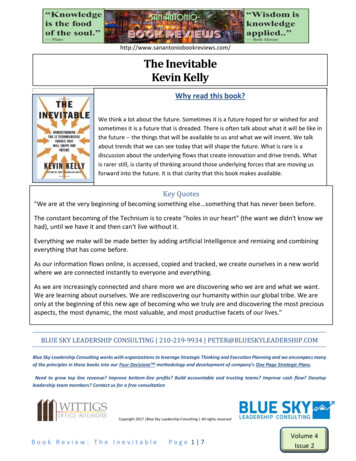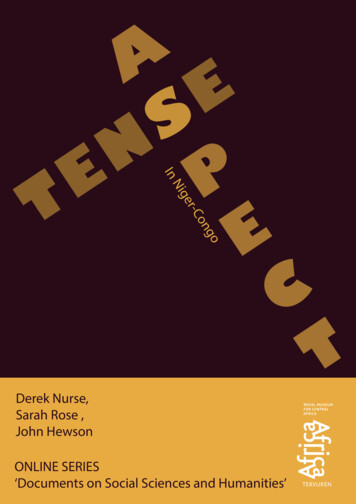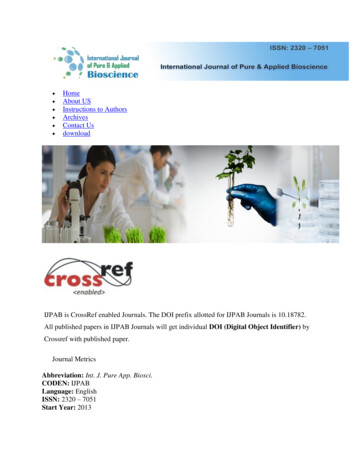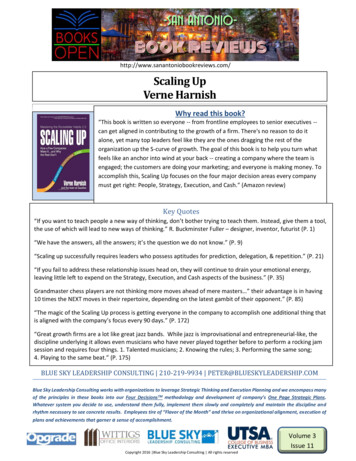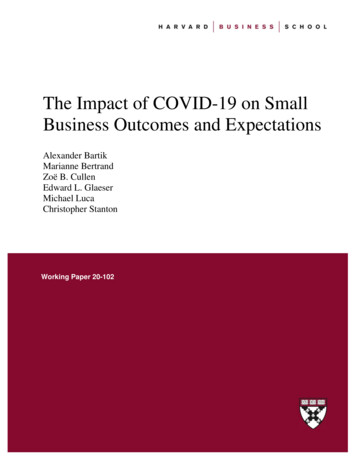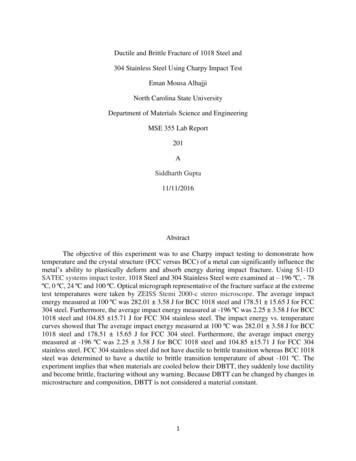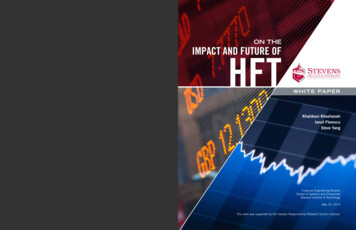
Transcription
ON THEIMPACT AND FUTURE OFHFTW H I T E PA P E RKhaldoun KhashanahIonut FlorescuSteve YangFinancial Engineering DivisionSchool of Systems and EnterprisesStevens Institute of TechnologyMay 10, 2014This work was supported by the Investor Responsibility Research Center Institute.
ON THE IMPACT AND FUTURE OF HFTABSTRACTThis white paper informs on the state of high frequency trading (HFT)mainly in the U.S. The paper addresses three major issues: First, itaddresses HFT as it is seen from various market agents’ perspectives,traders, institutional investors, regulators, academicians, and the public,collectively referred to as stakeholders. The paper establishes a surveyto get information on aspects of HFT. An examination of a HFT datasetverifies known trends and claims of HFT volume, price efficiency andWHITE PAPER1 - INTRODUCTION AND LITERATURE REVIEWHigh-quality trading markets promote capital formation and allocation by establishing prices for securities and byenabling investors to enter and exit their positions in securities wherever and whenever they wish to do so. Theone important feature of all types of algorithmic trading strategies is to discover the underlying persistent tradablephenomena and generate trading opportunities. These trading opportunities include microsecond price movementsthat allow a trader to benefit from market-making trades, several minute-long strategies that trade on momentumforecasted by market microstructure theories, and several hour-long market movements that surround recurringevents and deviations from statistical relationship (Aldridge (2010)). Algorithmic traders then design their tradingalgorithms and systems with the aim of generating signals that result in consistent positive outcomes underdifferent market conditions. Different strategies may target different frequencies, and the profitability of a tradingstrategy is often measured by a certain return metric.liquidity. Second, the paper examines the imminent problems and risksseen by various stakeholders from their vantage point. An assessment ofsources of risk posed by HFT to institutional investors and other components of the financial system reveals two types of risks to be examinedmore carefully: the first is HFT-driven systematic risk and the other is apotential HFT systemic risk. Third the paper examines possible solutionsto existing issues of HFT along with recent claims. We find that there aretwo classes of claims of unfair practices facing HFT: one is the insiderinformation through asymmetric access to information flows and theother is price manipulation claim. The paper introduces the concepts ofinformation transmission distance and systemic latency. We propose anew solution based on information transmission zoning concept, whichrequires minimum financial information flow re-architecting and no majorchanges in regulation NMS.Keywords: high frequency trading, institutional investors, data, finance,financial regulations, systemic risk, information transmission distance,In particular, there is a subgroup within the algorithmictrading strategies called High Frequency Trading (HFT)strategies that have attracted a lot of attention from investors, regulators, policy makers, and academics broadly. According to the U.S. Securities and Exchange Commission,high-frequency traders are “professional traders acting in aproprietary capacity that engage in strategies that generatea large number trades on daily basis.” (The SEC ConceptRelease on Equity Market Structure, 75 Fed. Reg. 3603,January 21, 2010). The SEC characterized HFT as (1) theuse of extraordinary high-speed and sophisticated computer programs for generating, routing, and executing orders;(2) use of co-location services and individual data feedsoffered by exchanges and others to minimize networkand other types of latencies; (3) very short timeframes forestablishing and liquidating positions; (4) the submission of numerous orders that are canceled shortly aftersubmission; and (5) ending the trading day in as close to azero position as possible (that is, not carrying significant,under-hedged positions over night). Although many HFTstrategies exist today and they are largely unknown to thepublic, researchers have shed lights on their general charFigure 1. Academic Research Papers on Algorithmic and High Frequency Trading Practicesacteristics recently. Several illustrative HFT strategiesinclude: (1) acting as an informal or formal market-maker,(2) high-frequency relative-value trading, and (3) directional trading on news releases, order flow, or other high-frequency signals (Jones (2012)).In the past few years, there have been a number of studies of HFT and algorithmic trading more generally. In thiswhite paper, we surveyed the 56 academic research papers, which had significant impact on our understandingof the algorithmic trading and HFT trading. These papers cover five primary topics concerning financial economicimpact, theoretical modeling, price discovery impact, limit order book dynamic modeling, and traders’ behaviorstudy of algorithmic and HFT trading practices. Figure 1 shows the distribution of these academic papers onthis subject. Among these five areas are three topics, which offer direct answer to the question whether algorithmic and HFT trading provides positive or negative value to the market overall quality. The remaining 44% of theresearch papers look into the trading mechanics and behavior of these participants in the market. These paperslay the foundation for others to answer direct questions. Next we then need to dive into each of the four clusters ofacademic findings and provide a thorough review on their results.systemic latency, insider information.1
ON THE IMPACT AND FUTURE OF HFTWHITE PAPER2FINANCIAL ECONOMIC RESEARCHORDER BOOK DYNAMICS MODELING STUDIESThe most influential topic regarding algorithmic and HFT addresses the financial and economic perspective.Their primary objective is to understand the financial economic impact of these algorithmic trading practices tothe market quality including liquidity, price discovery process, trading costs, etc. On the empirical side, some researchers have been able to identify a specific HFT in data, and others are able to identify whether a trade is fromalgorithmic traders. Given the amount of information provided by exchanges and data vendors, it is possible to describe patterns in algorithmic order submission, order cancellation, and trading behavior. It is also possible to seewhether algorithmic or HFT activities are correlated with bid-ask spreads, temporary and/or permanent volatility,trading volume, and other market activity and quality measures. Hendershott et al. (2011) study the implementation of an automated quote at the New York Exchange. They conclude that the implementation of auto-quoteis associated with an increase in electronic message traffic and an improvement in market quality includingnarrowed effective spreads, reduced adverse selection, and increase price discovery. These effects are concentrated in large-cap stocks, and there is little effect in small-cap stocks. Menkveld (2012) studies the July 2007entry of a high-frequency market-maker into the trading of Dutch stocks. He argues that competition betweentrading venues facilitated the arrival of this high-frequency market-maker and HFT more generally, and he showsthat high-frequency market-maker entry is associated with 23% less adverse selection. The volatility measuredusing 20 minutes realized volatility is unaffected by the entry of the high-frequency market-maker. Riordan et al.(2012) examine the effect of a technological upgrade on the market quality of 98 actively traded German stocks.They conclude that the ability to update quotes faster helps liquidity providers minimize their losses to liquiditydemanders, and more price discovery takes place. Boehmer et al. (2012) examine international evidence on electronic message traffic and market quality across 39 stock exchanges over the 2001-2009 period. They add thatco-location increases algorithmic trading and HFT, and that the introduction of colocation improves liquidity andthe information efficiency of prices. However, they claim volatility does not decline as much as it would be basedon the observed narrower bid-ask spreads. Gai et al. (2012) study the effect of two recent 2010 Nasdaq technology upgrades that reduce the minimum time between messages from 950 nanoseconds to 200 nanoseconds. Thesetechnological changes lead to substantial increase in the number of canceled orders without much change in overall trading volume. There is so little change in bid-ask spreads and depths. Overall, these studies have focused onempirical evidence that an increase in algorithmic trading has positive influence on market quality in general.The third topic area is concerned with modeling limit order book dynamics. Although these papers do not provide direct interpretation of influences of the algorithmic and HFT trading practices, they nevertheless offer greatinsight for researchers to understand the mechanics of these automated trading practices. Albert J. Menkveld(2007) looks to extend the Chowdhry and Nanda (1991) model to detect the presence of order-splitting tradersacross real world markets, in hopes of understanding the effects of trading in the fragmented markets. He observes that in the last few decades, it has become common for firms to cross-list their shares on different foreignexchange markets, which has proved to benefit firms by reducing the cost of capital and enhancing the liquidityof the stock. He concludes that it is the arrival of large liquidity trader volume and the lower profits of informedtraders that make the market more liquid in the overlap. Through empirical data, the paper finds that order-splitting as order imbalance is positively correlated across markets in the overlap and in the cross-section of Britishstocks, it significantly increases with NYSE small liquidity trading. John Y. Campbell et al. (2005) look at high-frequency trading information on equity transactions and quarterly information on institutional equity holdings todraw conclusions about institutional equity ownership. Changes in institutional ownership and order flow werethen used to show short-term covariance between institutional flows and equity returns across a broad selectionof stocks during the years of 1999-2000. They created a new method that gives results such that smaller buyvolume is associated with decreasing institutional ownership and large buy volume is associated with increasinginstitutional ownership. Extremely small buys also predict increasing institutional ownership which suggests thatinstitutions use the trades to test the liquidity of the market, to round small positions up or down, or to hide theiractivity. David Easley et al. (2012) present a new method of estimating flow toxicity based on volume imbalanceand trade intensity (VPIN). They assert that order flow is toxic when it adversely selects market makers, who maybe providing liquidity at a loss unknowingly. They suggest that VPIN can be a valuable risk management tool.Results shows that high levels of VPIN signify a high risk of subsequent large price movements, deriving from theeffects of toxicity on liquidity provision. Boyan Jovanovic and Albert J. Menkveld (2012) study how high frequencytrading might affect investor welfare in standard limit-order markets both theoretically and empirically. They document that a competitive sector of middlemen (high frequency traders) might reduce the informational friction,and therefore improve welfare, as information technology is at the heart of what they do. Their model also impliesthat regulations or fee structures that include HFTs to shift from producing price quotes to consuming themcould result in substantial welfare losses. Joel Hasbrouck (2012) studies variance on time scales of as small asfifty milliseconds for the National Best Bid and Offer in the US equity market. He shows that the highest quotedvolatilities occurred during the 2004-2006 time period, which ultimately corresponds to the transition to electronic trading in the markets. Based on empirical evidence, he concludes sub-second high frequency variance for theNational Best Bid and Offer are in excess of that would be expected when compared to random-walk volatility overlonger interval. These changes in volatility may be attributed to the change in market environment and the changeto electronic trading. Joel Hasbrouck and Gideon Saar (2013) propose a new measure of low-latency activity inorder to discover the impact of high frequency trading. This new measure is used to study how low-latency activityaffects market quality during normal market conditions and times of economic uncertainty. They conclude thatincreased low-latency activity improves market quality in the area of liquidity and short-term volatility. This type ofbehavior is true for both normal market activity and declining prices.FINANCIAL THEORETICAL MODELING RESEARCHThe second topic focuses on the theoretical modeling of the algorithmic and HFT trading practices. There are anumber of models developed to understand the economic impact of these algorithmic trading practices. Biaiset al. (2012) conclude HFT can trade on new information more quickly, generating adverse selection costs. Inaddition, HFT requires significant fixed investments in technology. Their model shows that only sufficiently largeinstitutions are likely to make these fixed investments. Smaller firms and investors are left to bear the adverseselection costs from HFT. Finally, they model the arms race feature of HFT. Iovanovic et al. (2010) show that HFTcan avoid some adverse selection, and can provide some benefit to uninformed investors who need to trade. Theirmodel shows that HFT can update limit orders quickly based on new information. As a result, HFT can avoid someadverse selection, and HFT can provide some of that benefit to uninformed investors who need to trade. Some ofthese trades might not have occurred otherwise, in which case HFT can improve welfare. Martinez et al. (2012)conclude from their model that HFT obtains and trades on information an instant before it is available to others,and it imposes adverse selection on market-makers. Therefore liquidity is worse and prices are no longer efficient.They focus on HFTs that demand liquidity, and suggest that HFT makes market prices extremely efficient by incorporating information as soon as it becomes available. Markets are not destabilized, as long as there is a populationof market makers standing ready to provide liquidity at competitive prices. Foucault, Hombert, and Rosu (2012)show that HFT obtains and trades on information an instant before it is available to others. This imposes adverseselection on market-makers, so liquidity is worse, and prices are no more efficient. Pagnotta et al. (2012) focuson the investment in speed made by exchanges in order to attract trading volume from speed sensitive investors.Moallemi et al. (2012) argue that a reduction in latency allows limit order submitters to update their orders morequickly, thereby reducing the value of the trading option that a limit order grants to a liquidity demander. Thecommon theme in these models is that HFT may increase adverse selection, and it is harmful for liquidity. However, the ability to intermediate traders who arrived at different times is generally good for liquidity.3
ON THE IMPACT AND FUTURE OF HFT4TRADING STRATEGIES STUDIESHF TRADERS BEHAVIORAL STUDIESThe forth topic addresses price discovery process with respect to algorithmic and high frequency trading practiceand their impact. As it is commonly acknowledged, price discovery is a way to measure efficiency of the market.Frank Zhang (2010) examines the implication of high frequency trading for stock price volatility and price discovery. He documents that HFT has become a dominant driver of trading volume in the U.S. capital market, and HFTstrategies are agnostic to a stock’s price level and have no intrinsic interest in the fate of companies, leaving littleroom for a firm’s fundamentals to play a direct role in its trading strategies. He finds that HFT is positively correlated with stock price volatility after controlling for firm fundamental volatility and other exogenous determinantsof volatility. He also finds that HFT is negatively related to the market’s ability to incorporate information aboutfirm fundamentals into asset prices, and stock prices tend to overreact to fundamental news when HFT tradingis at the high volume. Ryan Riodan and Andreas Storkenmaier (2011) document that the speed of trading is animportant factor in modern security markets, although relatively little is know about the effect of speed on liquidity and price discovery, two important aspects of market quality. Their results show that decreasing the latencyin a market leads to increased liquidity, mostly in small and medium sized stocks; the efficiency of prices clearlyimproves post upgrade, as does the relative contribution of quotes to price discovery. Their results also highlight alack of competition between liquidity suppliers, as the realized spread increases fourfold. This translates into anincrease in liquidity supplier revenues of roughly 185 million euros for the entire sample. Terrance Hendershottand Ryan Riordan (2011) examine the role of high-frequency traders in price discovery. They conclude that HFTplays a positive role in price efficiency by trading in the direction of permanent price changes and in oppositedirection of transitory pricing errors on average days and the highest volatility days. HFT passive non-marketableorders are adversely selected in terms of the permanent and transitory components of these traders are in thedirection opposite to permanent price changes and in the same direction as the pricing errors. They concludethat there is no evidence to say that HFT contribute to market instability in prices, in contrast, HFT overall tradesin the direction of reducing transitory pricing errors both on average days and on the most volatile days. DavidEasley et al. (2013) examine the impact on stock and market after a major upgrade that happened to the NewYork Stock Exchange in 1980 to improve its environment. This increase in transparency and reduction in transaction latency allowed off-floor traders to condition their orders on more up-to-date information and reduced the freetrading option that their limit orders provide. They also conclude that the competition enhancing upgrades alsogenerated relatively greater turnover and relatively lower transaction costs. The results of their study indicate thatthe latency that the traders experience is important for market participants and exchange alike. The results alsosuggest that leveling the playing field between the public and intermediaries leads to higher liquidity and higherprices. In our own study Bozdog et.al. (2011), we have discovered that mini market crashes are a much moreoften occurrence than previously known. We have created an algorithm to detect these mini-crashes, which wecall rare events and we show that they are related to pressure in the market and a lack of liquidity existing in themarket at the time of those events.Moreover, there have been a number of studies focused on algorithmic traders’ behaviors. These studies examine thetrading activities of different types of traders and try to distinguish their behavioral differences. Hendershott et al.(2012) use exchange classifications o distinguish algorithmic traders from orders managed by humans. They document that algorithmic traders concentrate in smaller trade sizes, while large block trades of 5,000 shares or more arepredominantly originated by human traders. Algorithmic traders consume liquidity when bid-ask spreads are relativelynarrow, and they supply liquidity when bid-ask spreads are relatively wide. This suggests that algorithmic tradersprovide a more consistent level of liquidity through time. Brogaard (2012) and Hendershott et al. (2011) work withNasdaq data and show whether trades involve HFT. Hendershott et al. (2011) find that HFT accounts for about 42%of (double-counted) Nasdaq volume in large-cap stocks but only about 17% of volume in small-cap stocks. They estimate a state-space model that decomposes price changes into permanent and temporary components, and measuresthe contribution of HFT and non-HFT liquidity supply and liquidity demand to each of these price change components. They find that when HFTs initiate trades, they trade in the opposite direction to the transitory component ofprices. Thus, HFTs contribute to price discovery and contribute to efficient stock prices. Brogaard (2012) similarlyfinds that 68% of trades have an HFT on at least one side of the transaction, and he also finds that HFT participationrates are higher for stocks with high share prices, large market caps, narrow bid-ask spreads, or low stock-specific volatility. He estimates a vector autoregressive permanent price impact model and finds that HFT liquidity suppliers faceless adverse selection than non-HFT liquidity suppliers, suggesting that they are somewhat judicious in supplyingliquidity. Kirilenko et al. (2011) use account-level tick-by-tick data on the E-Mini S&P 500 futures contract, and theyclassify traders into various categories, including HFTs, opportunistic traders, fundamental traders and noise traders.Benos et al. (2012) conduct a similar analysis using UK equity data. These different datasets provide considerableinsight into overall HFT trading behavior.WHITE PAPEROne of the goals of this study is to provide a comprehensive overview of the current academic research in HFT, sothat investment community and the public in general will be well informed of our current understanding of HFT andtheir influences related to such important economic issues as multiple characterizations of price formation processes,market liquidity, and order flow, etc. We assert that enhanced understanding of the economic implication of thesedifferent algorithmic and HFT trading strategies will yield quantitative evidence of value to market policy makers andregulators seeking to maintain transparency, fairness and overall health in the financial markets. Overall, althoughthere are still differences in opinion with regard to HFT and their impact to the market quality, a general consensussuggests that HFT provides liquidity and on average improves market quality, with more discernible positive effects inlarge-cap stocks. However, under distressed market conditions such as the 2010 Flash Crash, HFTs reportedly playeda very different role. Kirilenko, Kyle, Samadi, and Tuzun (2011) study HFT in the E-Mini S&P 500 futures marketduring the Flash Crash. Using audit trail data for nearly 15,000 accounts traded the E-Mini that day, and they findthat HFT did not trigger the Flash Crash, but their responses to the unusually large selling pressure on that day exacerbated the decline and worsened market volatility. In particular, as a large number of aggressive sell orders arrived,HFT initially provided liquidity. Within a few minutes, possibly because they were overwhelmed by selling pressure,HFT’s reversed course and aggressively liquidated their long positions, and thereby contributing to the price decline.The SEC, the national exchanges, and FINRA have since then agreed to and adopted single-stock circuit-breakers,which assuaged investor fears about the wholesale disappearance of liquidity over a short period of time. Thoughmost observers believe that these single-stock circuit breakers have generally worked well, they are sometimes triggered by a single erroneous trade on one trading venue, at a time when the market in that stock was operating in anorderly fashion on all other venues.The literature review only provides a survey of academic research findings on HFT and its role to the overall financialmarket health. Due to the limited data that academic society can access, the answers to questions regarding HFTs’economic merit and regulation surrounding HFT behaviors are far from being definitive. In the next section, we willuse online surveys and interviews to poll a broader range of interest groups in an effort to bring more knowledgeabout HFT to light.5
ON THE IMPACT AND FUTURE OF HFTWHITE PAPER62 - HFT SURVEYSURVEY DESIGNThe survey as designed has a total of 18 questions. The survey is anonymous but the surveyed individuals candeclare their name and email as answers to a non-mandatory question. The survey questions are divided in fourmajor categories. This is done for two reasons; firstly it allows the survey respondents, which are considered to beinformed agents in HFT, to understand the purpose of the specific questions asked. Secondly, it allowed us whendesigning the survey questions to concentrate on what each question asked in an attempt to eliminate unnecessary questions which will only make the statistical analysis of the survey results harder to perform.The four categories covered are:I. Demographic information about the survey takerII. Assessment of characteristic behavior of high frequency tradersIII. Assessment of impact of High frequency trading to the market behaviorIV. Assessment of need for regulating HFT in the futureA copy of the survey and the results is included at the end of this document in the Appendix.The survey has been given to the participants in the 5th Annual Modeling High Frequency Data in Finance (Oct24-26, 2013) held at Stevens Institute of Technology. The survey is still available and gathering answers . Thesurvey has additionally been distributed via email to over 200 specialists working with data sampled with highfrequency.The population of the survey was intended to reach three distinct groups. These groups are academics, financialindustry people working in the area, and regulators. One serious drawback we have encountered in the distributionof the survey is that the industry and regulators do not want to take the survey even though it is completely anonymous. As a consequence there is less representation of industry opinion and even less of the regulatory opinion.To counterbalance this drawback, which we did not anticipate initially, we perform analysis of data ourselves andtry to obtain objective answers supported by data to answer some of the survey questions. We intend to keep thesurvey accessible for the foreseeable future and collect opinions on the subject yearly. The survey results areshown in the appendix A.INTERPRETATION OF SURVEY RESULTSRather than going through each survey question (which we do in the Appendix A), here we want to state and interpret the survey’s results as of March 31, 2014. It is very clear from the answers received that there is a distinctduality in the answers we received. Most of the answers from academia on one side and from industry on the otherside seem to converge only on a few questions. In the section about characterizing HFT the answers from academia overall seemed less informed than the answers from industry. In the section on the HFT impact on the market both categories agreed, and with about the same ratios, that HFT provides liquidity to the market. However, asexpected the academia is much more reserved when asked questions such as “does HFT obscure price discovery”and “does HFT increase market volatility”. In the section on regulating HFT there is again a dichotomy in theanswers. Industry disagrees with the need of more regulations while the academia agrees with the need. However,when faced with the question which regulations should be imposed (Q16), academia selects random answers (thepercentages for the 4 questions are close to 25%). Industry on the other hand does not want to limit the rate atwhich quote messages are sent instead the least disliked option was to limit the order cancelation rate. The mostinteresting question for us was the last one which asked about investing in HFT. The distribution of answers to thisquestion is remarkably similar for both categories and the majority of answers (48.15%) selected: “I will invest insmarter algorithms for HFT because regulation is coming that will limit the frequency of the trades thus the needon relying on smarter rather than faster algorithms”.3 - HFT IMPACTMECHANICAL IMPACT ON MARKETThe mechanical impact on market can be measured from samples of data wherein HF trades can be separated fromnon-HF trades. Once that is achieved, several quantitative measures can be developed. Normally, access to this datais not allowed to researchers due to the sensitive nature of the information. However, we have obtained a “benchmark” sample of HFT data provided by the NASDAQ to HFT researchers. Analyzing this data has produced a numberof interesting results; however, we see that this white paper is not the place to go through them in details. Only a fewcomments on the results are included here.DataThe NASDAQ dataset contains trading and quoting activities of 26 HFT firms in 120 stocks on the NASDAQ exchange. In our analysis, we mainly use trade reports, of which the sample period covers all of 2008, 2009 and oneweek in 2010. Specifically, trade reports contain a field with the following codes: HH, HN, NH, or NN. H refers to aHFT firm and N refers to a non-HFT firm. The first term in the pair classifies the liquidity seeking side, and the second term classifies the liquidity supplier. For example, HN indicates that an HFT firm took liquidity from a non-HFTfirm. Obviously, HH is not very informative since both HFT firms are labeled as H in the sample.IndicesThe volume index is the number most mentioned in the literature related to HFT trading and it refers to the percentage of the total trades which is attributed to HFT. Table 1 shows the percentages for years 2008, 2009 and twoweeks in 2010. Indeed,
of the algorithmic trading and HFT trading. These papers cover five primary topics concerning financial economic impact, theoretical modeling, price discovery impact, limit order book dynamic modeling, and traders’ behavior study of algorithmic and HFT trading practices. Figure 1 shows t



